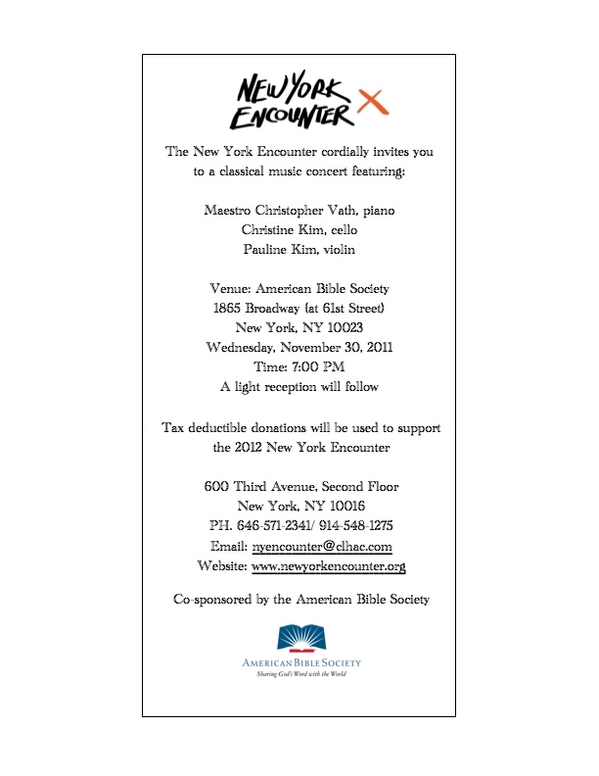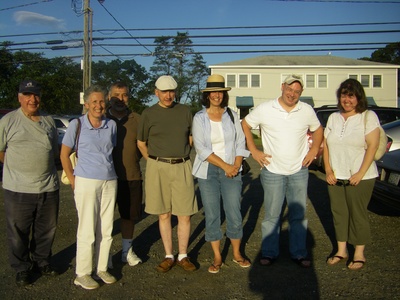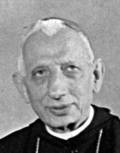Tag: Communion and Liberation
Fr Aldo Trento speaks to a new life in Christ amid suffering
 Father Aldo Trento, 64, hails from Belluno, Italy. Father Aldo is a priest of the Missionary Fraternity of Saint Charles Borromeo and has been living in Paraguay since 1989; currently he is the pastor of San Rafaél Church, Asunción. The life of this parish generated the Clinic “Divine Providence Saint Richard Pampuri Home” for the terminally ill and for the poor. Moreover, Father Aldo has established an elementary school, a shelter for pregnant women who suffered sexual abuse, four homes for orphans affected by HIV/AIDS, a shelter for chronically-ill children, and two residences for poor and abandoned elderly people. At the present time they are building new facilities for the Clinic as well as a vocational school with several subject concentrations to facilitate the introduction of the youths who complete their primary education at Pai Alberto School into the job market. In June 2008, Father Aldo has been named a “Knight of the Star of Solidarity”, by the president of Italy, Giorgio Napolitano. In September 2008 he was also designated an illustrious citizen of the city of Asunción by the City Council.
Father Aldo Trento, 64, hails from Belluno, Italy. Father Aldo is a priest of the Missionary Fraternity of Saint Charles Borromeo and has been living in Paraguay since 1989; currently he is the pastor of San Rafaél Church, Asunción. The life of this parish generated the Clinic “Divine Providence Saint Richard Pampuri Home” for the terminally ill and for the poor. Moreover, Father Aldo has established an elementary school, a shelter for pregnant women who suffered sexual abuse, four homes for orphans affected by HIV/AIDS, a shelter for chronically-ill children, and two residences for poor and abandoned elderly people. At the present time they are building new facilities for the Clinic as well as a vocational school with several subject concentrations to facilitate the introduction of the youths who complete their primary education at Pai Alberto School into the job market. In June 2008, Father Aldo has been named a “Knight of the Star of Solidarity”, by the president of Italy, Giorgio Napolitano. In September 2008 he was also designated an illustrious citizen of the city of Asunción by the City Council.
Father Aldo’s amazing witness can be heard here on an audio file. It was recorded October 20, 2011, at the NY CL Offices.
Julián Carrón speaks on the New Evagelization, relationship between the Gospel and culture
On October 14, 2011 Pope Benedict XVI received Father Julián Carrón, President of the Fraternity of Communion and Liberation, in audience in the Apostolic Palace, the day before the Vatican meeting on “New Evangelizers for a New Evangelization,” a two day event that will culminate in the Mass with the Pope on Sunday at 9:30 in Saint Peter’s Square. What follows is an interview with Vatican Radio’s Alessandro Gisotti (emphasis mine).
Alessandro Gisotti interviewed Fr. Carrón about tomorrow’s meeting and the challenge of the new evangelization.
Father Julián Carrón: The first thing I would like to express is how grateful and moved I am at this opportunity the Holy Father has given me to be with him in this audience, because it enabled me to tell him how, in this moment of travail due to the social, cultural, and economic situation, we are seeing that when people verify the faith in their own life circumstances, they flower into a type of person that leaves us speechless. Being able to share with him living the faith, as he testifies it to us, was a true consolation.
How important is this meeting? How important is the Pope’s challenge for a new evangelization?
Peter John Cameron speaks on Luigi Giussani, the priest wounded by beauty
 On October 8, 2011, a film series co-sponsored by the Siena Forum for Faith and Culture and Crossroads Cultural Center on extraordinary Christian lives concluded with the showing of the documentary conducted by Elena Guarnieri of “Vita Straordinarie: Don Luigi Giussani” (Extraordinary Lives: Fr. Luigi Giussani”) on the life and work of Monsignor Luigi Giussani, called: the priest wounded by beauty by Pope Benedict when he offered the Sacrifice of the Mass for the repose of Giussani’s soul on 25 February 2005.
On October 8, 2011, a film series co-sponsored by the Siena Forum for Faith and Culture and Crossroads Cultural Center on extraordinary Christian lives concluded with the showing of the documentary conducted by Elena Guarnieri of “Vita Straordinarie: Don Luigi Giussani” (Extraordinary Lives: Fr. Luigi Giussani”) on the life and work of Monsignor Luigi Giussani, called: the priest wounded by beauty by Pope Benedict when he offered the Sacrifice of the Mass for the repose of Giussani’s soul on 25 February 2005.
Traces magazine: there’s an app for it on iPad
Great news with you: Traces is now available for iPad users and users of Apple’s latest OS, Lion. All that is necessary is to go to the App Store and enter “Traces” and you will find it.
There are many, pretty obvious, advantages to this new form, including receiving Traces as soon as it’s published, paying less for a subscription and the ability to easily tell friends who have an iPad.
I hope all of you Apple and iPad users will sign up, immediately, and tell your friends!
Friends after dinner by a Branford Marsh
God launches us into life’s adventure with the grace needed to succeed, Father Julián Carrón reminds
The Mystery, however has not launched us into the
adventure of life without providing us with a compass with which to find our
bearings. This compass is the heart. In our epoch, the heart has been reduced
to a feeling, a question of mood, but we can all recognize in our experience
that the heart does not allow itself to be reduced, it will not be conformed to
anything. “Men and women were created for something great, for infinity.
Nothing else will ever be enough.” The Pope says in his Message, and we know it
very well.
begins to have a criterion for judging the truth or the falsity of whatever
proposal dawns on the horizon of his life. “You are constantly being offered
easier choices, but you yourselves know that these are ultimately deceptive and
cannot bring you serenity and joy.”
Christ begging for the heart of man
A bold abbot, Communion and Liberation, the BVM and Saint Benedict
 Today is the 31st anniversary of the foundation of Fraternity of Communion and Liberation. The narrative of the Fraternity’s founding is told in “The Greatest Grace in the History of the Movement” by Giorgio Feliciani (Traces, February 2007). Here’s the story.
Today is the 31st anniversary of the foundation of Fraternity of Communion and Liberation. The narrative of the Fraternity’s founding is told in “The Greatest Grace in the History of the Movement” by Giorgio Feliciani (Traces, February 2007). Here’s the story.
A priest in the direct service of the Holy See, Monsignor Mariano De Nicolò, currently Bishop of Rimini [he retired 3 July 2007], happened to review, as part of his official duties, a file that illustrated and documented the Movement’s desiderata. Feeling that these aspirations deserved attention and further study, he suggested to Father Francesco Ricci, who at the time was sharing responsibility for the Movement with Father Giussani [for more about this priest, who died in 1991, see Francesco Ricci. Una passione, cento passioni,
San Martino in Strada, Lit. Citienne, 1996], that he consult with Monsignor Giuseppe Lobina, an expert in Canon Law who, along with a solid formal training, had an unusual amount of experience with ecclesiastical praxis.
This advice was promptly taken and, only a few months later, Monsignor Lobina, after acquiring all the necessary information in various meetings with CL figures and Father Giussani himself, was drawing up what would soon be the Statute of the Fraternity, which has remained largely unchanged up to now.
Monsignor Lobina also undertook to find the ecclesiastical authority willing to approve the Movement, and found him in Abbot Martino Matronola, who, as provost [abbot] of the monastery of Montecassino, had the same powers over the surrounding territory as the bishop of a diocese. This acceptance was even more welcome because Father Giussani felt that the concept of his Movement was very close to that of the Benedictines (see Giussani, op.cit., pp. 74-75).
The formal establishment of the Fraternity came shortly thereafter in a very discreet, unassuming way. On July 11, 1980-the solemnity of Saint Benedict, Patron of Europe, on the fifteenth centenary of his birth-a small group of twelve stood together with Father Giussani in front of the Abbot to be constituted as a canonical association. On that same day, Monsignor Matronola,* by a specific formal decree, granted juridical status in the Church to the ecclesial movement called “Fraternity of Communion and Liberation” and approved its statutes and “works of apostolate and individual and social formation,” placing it under the “protection of the Immaculate Virgin and our Patron Saint Benedict” (see the Bollettino Diocesano di Montecassino, no. 3, 1980, pp. 223-224).
Thus, the Fraternity was born as a reality in the Church, recognized to all effects by the ecclesiastical authority and by virtue of this formal empowerment to act, in communion with its respective bishops, not only in Montecassino but also in the other dioceses. Indeed, in the same decree, the Abbot expressed his “fervent wish that wherever the Association exercises its apostolic activity, it may be benevolently welcomed, aided, and encouraged by their Excellencies the Ordinaries.”…
Despite the lack of any kind of organized promotion, adherence to the Fraternity was growing rapidly, to the point that within a year the number of members went from the original 12 to almost 2,000. …
The Abbot of Montecassino was certainly aware that his decree would provoke harsh criticism from those bishops who did not view CL with a favorable eye. One of the leading figures in the Italian Bishops Conference went so far as to state that the decree had been illegally extorted from him. And, realistically, an attentive Canon lawyer noted, “The Abbot of Montecassino was brave (some would say bold) to approve an association that is not diocesan, but evidently multi-diocesan.” In this situation, the recognition generously and courageously granted by the Abbot of Montecassino was no longer sufficient to give the association a juridical form that corresponded with its actual reality. By now, the approval of a higher authority was needed, which could only be the Holy See, and more specifically the Pontifical Council for the Laity, the dicastery set up by Pope Paul VI to handle matters concerning the participation of the laity in the life and mission of the Church.
Consequently, as early as April 7, 1981, less than a year after the decree issued by the Abbot of Montecassino, Father Giussani, with the continued encouragement and advice of Monsignor Lobina, sent the President of the Council, at that time Cardinal Opilio Rossi, a formal application for pontifical recognition of the Fraternity. …
In the end, the Holy Father, John Paul II himself, intervened: after being fully informed about the question, he encouraged the Pontifical Council to proceed to grant the desired approval without further delay (according to the Decree of the Pontifical Council for the Laity, p. 235).
Thus, we come to the Decree, issued on February 11, 1982, the liturgical feast of Our Lady of Lourdes, which “establishes and confirms as a juridical entity for the universal Church” the Fraternity, “declaring it to all effects an Association of Pontifical Right and decreeing that it be recognized as such by all.”
As is known, February 11, 1982, the Feast of Our Lady of Lourdes, is recognized as the establishment of the Fraternity of Communion and Liberation. It is this date that CL prays the Mass for the good of the Fraternity. Historically, as noted above, the Archabbot of Monte Cassino, on Saint Benedict’s 1500th birthday, recognized the CL as an ecclesial movement, an act that caused much criticism for being perceived as taking authority not his own. Two years later Pope John Paul II addressed the criticism, and on the feast of Our Lady of Lourdes had the Fraternity of Communion and Liberation recognized by the Pontifical Council for the Laity under the leadership of Opilio Cardinal Rossi. Hence, Our Lady of Lourdes and Saint Benedict are patrons of the Fraternity Communion and Liberation.
*Martino Matronola (1903-1994) was born in Cassino, Italy, the city below the great Benedictine abbey of Monte Cassino where he was elected the archabbot in 1971 and appointed bishop in 1977. The Abbey of Monte Cassino is known as the archcoenobium because it is the one of the monasteries founded Saint Benedict; the abbey is also distinguished for being an abbey-nulius (a territorial abbey, meaning the abbey is responsible for a number of parishes). Therefore, the man elected the archabbot of Monte Cassino is also the Diocesan Ordinary of the Diocese of Cassino which has 53 parishes, 68 priests and 79,000 faithful to care for (according to 2004 stats). He retired from the position of abbot-bishop of Monte Cassino in 1983.
Father Carrón clarifies The Meaning of Charitable Work
Today, I had the opportunity to speak to Father Julián Carrón so as to clarify an aspect of what the Movement of Communion and Liberation understands its founder, Father Luigi Giussani to mean by doing charitable work. One of the central characteristics in the life of the Fraternity of Communion and Liberation is doing charitable work, where I see “the final powerlessness of my love” and the presence of Christ now.
Continue reading Father Carrón clarifies The Meaning of Charitable Work




